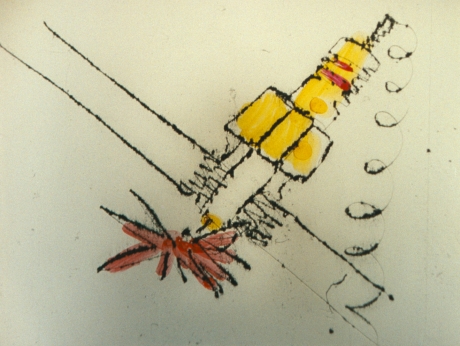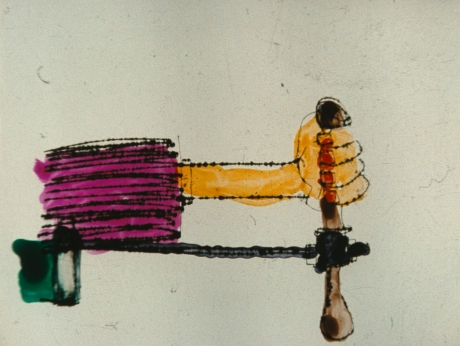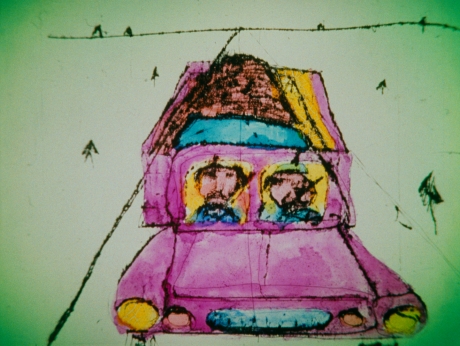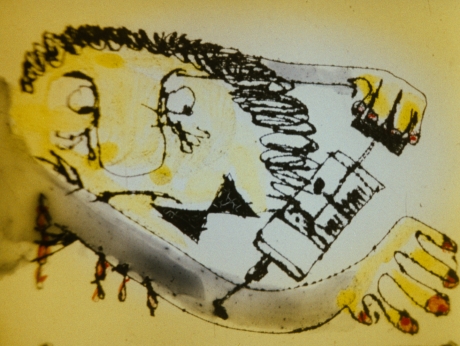
 overview
overview

 storyline
storyline
A red, black-maned, sad sun. A gathering of uneasy and curious-looking people. They chat excitedly, stretch out their necks, they have bulging eyes. There is an omnipresent feeling of anticipation of some crucial event. The atmosphere all over is anything but calm: the air is filled with anxiety and turns people to violence. Someone bites another person in the ear, someone is pinched in the nose, someone else’s head is pinned to the ground. A frightened, elderly man leaves his coffin, a woman hits her husband's head with an umbrella, a car hits a streetlight, bells ring, a skeleton with a scythe appears. The red sun shines increasingly stronger, trees bend, an atmosphere of horror mounts up and the suspense becomes unbearable.

 comment
comment



















Subsequent to ‘The Sun - A Non Camera Film’ (1977), ‘The Disaster (Non Camera)’ serves as another example of an animation shot by Julian Józef Antonisz entirely in ‘non-camera’, a technique explored by the artist throughout his entire career starting from his debut ‘The Phobia’, directed mostly in non-camera. However only starting from the year 1977 did the artist put the idea of non-camera filmmaking into consequent practice.
‘The feebleness of animation lies in the supremacy of technology over art’ - he told me once. ‘The end of film came with August and Louis Lumière’ – he often perversely repeated. It was the non-camera technique that he considered the only way to positively rejuvenate the art of film. One of the several manifestos published by Antonisz on the subject read: ‘Non camera is a circumvention of the whole technical and bureaucratic machine that alienates a filmmaker from the end product of his work. What I strive for is such an uttermost simplification of the production technique that the movie is drawn away as far as possible from the industry so it can be brought back closer to its author’.
Thus came Antonisz's commitment to film that's entirely auteur. He was the only writer of his scripts, which he later transferred onto tape (with the only co-worker allowed in the process of filmmaking being his wife, Danuta Zadrzyńska, a Cracow Academy Of Fine Arts' graduate), he was the composer and performer of scores (the composing process which would often involve experiments on non-camera sounds). He would only hire assistants to perform commentaries and songs (like in the notorious ‘A Hard-Core Engaged Film. Non Camera'), like Aniela Jaskólska, the Cracow Animated Film Studio’s cleaning lady, or Andrzej Olszański (in ‘Polish Non-Camera Newsreel’), the same studio's director, who also, incidentally, was the Actors' Faculty of Cracow's Academy for the Dramatic Arts' graduate. The opening and closing of ‘The Disaster (Non Camera)’ both feature the process of making a non-camera film. It's a device Antonisz would often include to present the viewers with ‘how the magic works’. Later, after the opening credits have rolled, Antonisz conveys what could be called a stream of consciousness and imagination. What we are now presented with are repetitive motives which are familiar from his other films: contorted human faces, eyes bulging, heavy boots treading upon flowers in bloom, ever rushing feet, various acts of violence, accidents and disasters. Accelerating images freezing suddenly, serving as kinds of accents, bleak music - all of these render an unsettling, suspenseful collage corresponding with the ambience of anticipation. The disaster seems to be inevitable. Jerzy Armata